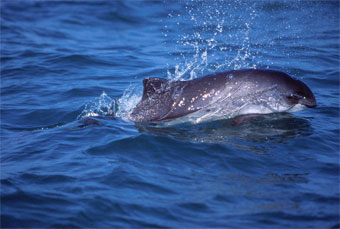Harbor Porpoise
Harbor Porpoise Sounds (Phocoena phocoena)
Description

The harbor porpoise is one of the smallest cetaceans- adults are 1.4-1.9 m (4.5-6 ft) in length and can weigh up to 90 kg (198 lb). Image courtesy of Ari Friedlander/NOAA.
The harbor porpoise is found throughout the temperate and sub-polar coastal waters of the North Pacific, North Atlantic, and Black Sea. Porpoises in each ocean basin are reproductively isolated. There are two subspecies: P. phocoena vomerina in the Pacific Ocean and P. phocoena phocoena in the Atlantic Ocean. There is a third possible subspecies in the Black Sea, P. phocoena relicta. Harbor porpoises are often found in small groups that contain at least one mom/calf pair. As seen in other members of the porpoise family, harbor porpoises have tubercles (small, hard bumps) on the leading edge of their dorsal fin, and possess spade-shaped, or spatulate, teeth (dolphins have conical, or cone-shaped, teeth). They eat small fish and squid and feed near the bottom in waters less than 200 m. Onshore/offshore migrations and movements parallel to the coast have been noted for the species and are thought to mirror the seasonal movements of their prey.
Like other odontocetes, harbor porpoises use echolocation for feeding and orientation. The dominant components of harbor porpoise echolocation signals are narrowband, high-frequency (ultrasonic) clicks within 110-150kHz. This is consistent with their hearing, with best sensitivity between 100 and 120 kHz. Click duration ranges from about 60 µs to 300 µs and the clicks are usually emitted in a series called a click train. Harbor porpoises produce intense click trains where the inter-click interval within a train ranges between 20 and 80 msec. This can decrease to less than 2 msec, especially when the animal is nearing its target: i.e., a fish. At this time the click train will actually sound more like a “buzz”.
Due to the coastal distribution of the harbor porpoise, conflicts arise between the species and humans. The primary human-induced threat to the harbor porpoise is bycatch in commercial fishing gear. Several harbor porpoise populations are in decline, at least partly as a result of entanglement in gillnet gear. In New England and mid-Atlantic waters of North America, attempts are being made to reduce harbor porpoise bycatch. The Harbor Porpoise Take Reduction Plan (HPTRP) is a suite of U.S. federal regulations that requires fishermen to use underwater acoustic alarms (pingers) on their nets and modify fishing gear configurations to reduce entanglement. The plan also implements area closures where gillnet fishing is prohibited. Conservation plans for harbor porpoises in European waters are also being developed by the Agreement on the Conservation of Small Cetaceans of the Baltic and North Seas (ASCOBANS).
Harbor porpoise echolocation clicks originally recorded on a tagged porpoise during a prey capture experiment. Listening, you can hear some clicks, then a series of faster clicks (the buzz) around the time of capture. After capturing the fish, the porpoise goes back to slower clicking. Note: This sound has been modified to be audible to the human ear. Thus, what you hear when you listen is the real rate at which the porpoise made the clicks, but not the actual clicks (which are ultrasonic).
Sound courtesy of Stacy DeRuiter, Woods Hole Oceanographic Institution. Released under Creative Commons non-commercial attribution v3 license.
Additional Links on DOSITS
Additional Resources
- Scripps Institution of Oceanography, Voices in the Sea